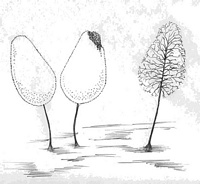|
 Comatricha laxa Comatricha laxa
BiostatusPresent in region - Indigenous. Non endemic
Images (click to enlarge)
Caption: Three sporangia of Comatricha laxa, each of which is about 2 mm tall.
Owner: S.L. Stephenson |
Article: Stephenson, S.L. (2003). Myxomycetes of New Zealand. Fungi of New Zealand. Ngā Harore o Aotearoa 3: xiv + 238 p. Hong Kong: Fungal Diversity Press.
Description: Fruiting body a stalked sporangium, scattered to gregarious, usually 1.0–3.5 mm tall but sometimes smaller. Sporotheca subglobose to ovate or short-cylindrical, erect, purplish or reddish brown, becoming paler as the spores are shed, up to 0.4 mm in diameter. Stalk black, shining, often short, usually less than one-half the total height, but in forms with a globose sporotheca reaching two-thirds the total height, tapering from an expanded base. Hypothallus inconspicuous. Peridium fugacious. Columella erect, rigid, usually reaching nearly to the apex of the sporotheca, rarely shorter and forking in globose forms. Capillitium open, arising from all parts of the columella, the primary branches more or less horizontal, with few anastomoses and many short, free tips. Spores deep reddish brown in mass, greyish brown or liliaceous by transmitted light, minutely and irregularly warted, 8–10 µm in diameter. Plasmodium watery-white.
Habitat: Decaying wood, leaf litter and other types of plant debris; also appearing on tree bark in moist chamber cultures.
Distribution: Probably cosmopolitan (Ing 1999), but most records are from temperate regions of the Northern Hemisphere (Martin & Alexopoulos 1969). First reported from New Zealand by Mitchell (1992), based on a specimen appearing in moist chamber cultures on bark of Populus nigra collected in North Canterbury. Also known from Auckland and Wairarapa.
Notes: The more or less horizontal primary branches of the capillitium distinguish Comatricha laxa from other species of Comatricha characterized by a short stalk and an ovoid to short cylindrical sporotheca
|